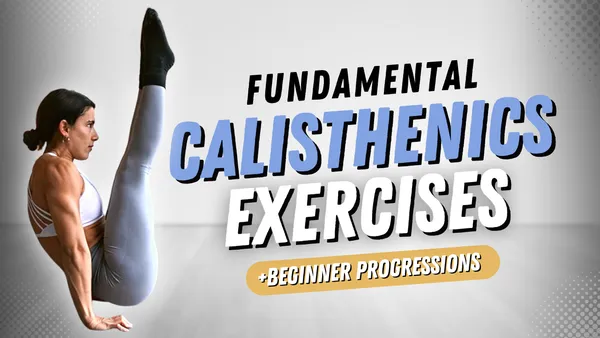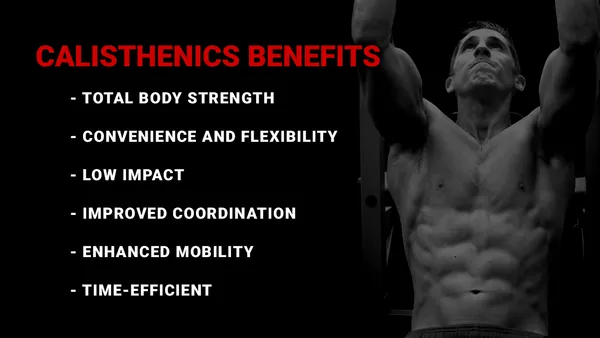Table of Contents
Calisthenics, a form of exercise that uses bodyweight to improve strength, flexibility, and endurance, has been around for centuries. Today, it's more popular than ever, as people seek ways to get fit without expensive equipment or gym memberships. If you're new to calisthenics, understanding its meaning is important. At Kizworld, we'll delve into the basics of calisthenics, exploring its history, benefits, and different types of exercises involved. Whether you're a beginner looking to start your fitness journey or an experienced athlete seeking to enhance your skills, this guide will provide you with valuable insights into the world of calisthenics. So, get ready to unlock your fitness potential and discover the transformative power of bodyweight training.
Calisthenics Meaning: A Comprehensive Guide to Bodyweight Training
Key Takeaway | Description |
|---|---|
Meaning of Calisthenics | "Calisthenics" refers to a form of exercise that utilizes bodyweight for resistance training, focusing on strength, mobility, and agility. |
Historical Origins | Calisthenics emerged centuries ago in ancient Greece, where it played a crucial role in military training and physical education. |
Key Components | Calisthenics encompasses a wide range of exercises, including push-ups, pull-ups, squats, and core work, all performed using bodyweight alone. |
Benefits | Engaging in calisthenics offers a wealth of benefits, such as building strength, improving endurance, boosting metabolism, and enhancing flexibility. |
Incorporating Calisthenics | To start calisthenics, begin with simple exercises and gradually increase intensity and complexity as you progress. |
Advanced Techniques and Skills | Advanced calisthenics involves mastering more challenging exercises like muscle-ups, handstands, and planche progressions. |
Building Community | Join online forums or meetups to connect with like-minded individuals, share knowledge, and find encouragement for your calisthenics journey. |
Visit Kizworld for More Resources | Delve deeper into the world of calisthenics and discover personalized workout plans, advice, and a supportive community on Kizworld. |
I. Calisthenics: A Comprehensive Guide to Meaning and Benefits
Meaning and Definition of Calisthenics
Calisthenics, derived from the Greek words "kallos" (beauty) and "sthenos" (strength), is a form of exercise that utilizes bodyweight as resistance to enhance strength, mobility, and agility. It involves a wide range of movements, including push-ups, pull-ups, squats, and core work, performed without the use of external weights or equipment. Calisthenics aims to develop functional strength, improve cardiovascular health, and enhance overall physical fitness.Calisthenics has gained popularity in recent years due to its accessibility, effectiveness, and versatility. It can be practiced anywhere, requires minimal equipment, and can be tailored to different fitness levels. Whether you're a beginner looking to improve your overall fitness or an experienced athlete seeking to enhance your performance, calisthenics offers a comprehensive approach to physical training.
Benefits of Calisthenics
Engaging in calisthenics provides numerous benefits for individuals of all ages and fitness levels. These benefits include:
- Increased Strength and Muscle Mass: Calisthenics exercises challenge your muscles, leading to increased strength and muscle growth.
- Improved Endurance and Cardiovascular Health: Calisthenics workouts often involve compound movements that engage multiple muscle groups, improving endurance and cardiovascular fitness.
- Enhanced Flexibility and Mobility: Calisthenics exercises often incorporate dynamic movements that improve flexibility and range of motion.
- Reduced Risk of Chronic Diseases: Regular calisthenics practice can help reduce the risk of chronic diseases such as heart disease, stroke, and type 2 diabetes.
- Improved Body Composition: Calisthenics helps burn calories and build lean muscle, leading to improved body composition.
In addition to these physical benefits, calisthenics can also provide mental and emotional benefits, such as improved mood, reduced stress, and increased self-confidence. It's a form of exercise that can be both challenging and rewarding, making it an enjoyable way to improve your overall well-being.
Benefit | Description |
|---|---|
Increased Strength and Muscle Mass | Calisthenics exercises challenge your muscles, leading to increased strength and muscle growth. |
Improved Endurance and Cardiovascular Health | Calisthenics workouts often involve compound movements that engage multiple muscle groups, improving endurance and cardiovascular fitness. |
Enhanced Flexibility and Mobility | Calisthenics exercises often incorporate dynamic movements that improve flexibility and range of motion. |
Reduced Risk of Chronic Diseases | Regular calisthenics practice can help reduce the risk of chronic diseases such as heart disease, stroke, and type 2 diabetes. |
Improved Body Composition | Calisthenics helps burn calories and build lean muscle, leading to improved body composition. |
If you're interested in incorporating calisthenics into your fitness routine, it's important to start gradually and listen to your body. Begin with simple exercises and gradually increase the intensity and complexity as you progress. There are numerous resources available online and in fitness communities to help you learn proper form and technique. With consistency and dedication, calisthenics can be a transformative form of exercise that empowers you to achieve your fitness goals.
II. Historical Roots and Evolution of Calisthenics
Ancient Origins
Calisthenics traces its roots back to ancient Greece, where it played a pivotal role in military training and physical education. The term "calisthenics" is derived from the Greek words "kalos" (beautiful) and "sthenos" (strength), reflecting the belief that these exercises could enhance both physical and aesthetic qualities. Greek soldiers engaged in calisthenics to develop strength, agility, and endurance, preparing them for the rigors of battle.Read more about the history of calisthenics
Modern Adaptations
In the 19th century, calisthenics gained popularity in Europe and North America as a form of physical training for both men and women. Educators and physical culturists promoted calisthenics as a means to improve overall health, posture, and coordination. During World War I and II, calisthenics was incorporated into military training programs to enhance soldiers' physical fitness and combat readiness.
Year | Event |
|---|---|
1828 | Friedrich Ludwig Jahn, a German physical educator, develops the first calisthenics system. |
1896 | Calisthenics is included in the first modern Olympic Games in Athens. |
1918 | The U.S. Army adopts calisthenics as part of its physical training program. |
Contemporary Calisthenics
In recent decades, calisthenics has experienced a resurgence in popularity as a form of bodyweight training. With the advent of social media and online fitness communities, calisthenics enthusiasts have shared their knowledge and skills, inspiring a new generation of practitioners. Today, calisthenics is practiced worldwide by individuals of all ages and fitness levels, offering a versatile and effective way to improve physical fitness and overall well-being.Discover the benefits of calisthenics
III. Practical Applications and Types of Calisthenics Exercise
Calisthenics exercises can be performed anywhere, making them a versatile and accessible form of fitness. They can be incorporated into a variety of workout routines, from beginner to advanced. Some common types of calisthenics exercises include:
- Push-ups
- Pull-ups
- Squats
- Lunges
- Planks
- Burpees
- Mountain climbers
- Jumping jacks
These exercises can be modified to suit different fitness levels. For example, beginners can start with bodyweight squats and gradually add weight as they get stronger. Advanced calisthenics exercises include muscle-ups, handstands, and planche progressions.Calisthenics exercises can be used to improve strength, endurance, flexibility, and balance. They can also help to build muscle and burn fat. Calisthenics is a great way to get in shape and improve your overall health.How to Do a Muscle-Up
Exercise | Benefits |
|---|---|
Push-ups | Strengthens chest, shoulders, and triceps |
Pull-ups | Strengthens back, biceps, and forearms |
Squats | Strengthens legs, glutes, and core |
Lunges | Strengthens legs, glutes, and core |
Planks | Strengthens core, back, and shoulders |
If you are new to calisthenics, it is important to start slowly and gradually increase the intensity of your workouts. It is also important to listen to your body and rest when you need to. With consistency and dedication, you can achieve your fitness goals with calisthenics.The Best Calisthenics Gifts and Accessories
Practical Applications and Types of Calisthenics Exercise
IV. Calisthenics at Home: Creating an Effective Workout Routine
Getting Started with Calisthenics at Home
Calisthenics is a great way to get fit at home without any equipment. It's a bodyweight training method that uses your own body weight as resistance. Calisthenics exercises can be modified to suit all fitness levels, making it a great option for beginners and experienced athletes alike.To get started with calisthenics at home, you don't need any special equipment. You can use a chair, a wall, or even just the floor. Start with simple exercises like push-ups, squats, and lunges. As you get stronger, you can add more challenging exercises like pull-ups, dips, and muscle-ups.Here are some tips for creating an effective calisthenics workout routine at home:
- Start with a warm-up to prepare your body for exercise.
- Choose exercises that target all major muscle groups.
- Start with a few sets of each exercise and gradually increase the number of sets and repetitions as you get stronger.
- Rest for 30-60 seconds between sets.
- Cool down with some stretching after your workout.
Sample Calisthenics Workout Routine
Here is a sample calisthenics workout routine that you can try at home:
- Warm-up: 5 minutes of light cardio, such as jumping jacks or running in place.
- Push-ups: 3 sets of 10-12 repetitions.
- Squats: 3 sets of 10-12 repetitions.
- Lunges: 3 sets of 10-12 repetitions per leg.
- Pull-ups: 3 sets of 8-10 repetitions (if you can't do pull-ups, you can use a resistance band or a chair to assist you).
- Dips: 3 sets of 8-10 repetitions (if you don't have a dip bar, you can use a chair or a bench).
- Muscle-ups: 3 sets of 5-8 repetitions (if you can't do muscle-ups, you can work up to them by doing pull-ups and dips).
- Cool-down: 5 minutes of stretching.
You can adjust this workout routine to fit your own fitness level and goals. If you're a beginner, start with fewer sets and repetitions and gradually increase the intensity as you get stronger.
Benefits of Calisthenics
Calisthenics offers a number of benefits, including:
- Improved strength and muscle mass.
- Increased flexibility and mobility.
- Enhanced cardiovascular health.
- Reduced body fat.
- Improved balance and coordination.
- Increased energy levels.
- Reduced stress and anxiety.
Calisthenics is a great way to get fit and improve your overall health and well-being. It's a versatile and challenging form of exercise that can be enjoyed by people of all ages and fitness levels.Learn more about the benefits of calisthenics
Exercise | Benefits |
|---|---|
Push-ups | Strengthens chest, shoulders, and triceps |
Squats | Strengthens legs, glutes, and core |
Lunges | Strengthens legs, glutes, and core |
Pull-ups | Strengthens back, biceps, and forearms |
Dips | Strengthens chest, shoulders, and triceps |
Muscle-ups | Strengthens back, biceps, forearms, and core |
Calisthenics at Home: Creating an Effective Workout Routine
V. Conclusion
Calisthenics is a great way to get fit and healthy. It is a fun and challenging way to exercise, and it can be done anywhere, anytime. If you are looking for a way to improve your fitness, calisthenics is a great option.